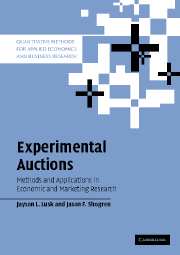Book contents
- Frontmatter
- Contents
- List of figures
- List of tables
- 1 Introduction
- 2 Incentive compatible auctions: theory and evidence
- 3 Value theory
- 4 Conducting experimental auctions: some preliminaries
- 5 Conducting experimental auctions
- 6 Data analysis
- 7 Valuation case studies
- 8 Auction design: case studies
- 9 Validity of experimental auctions
- 10 The future of experimental auctions
- References
- Index
5 - Conducting experimental auctions
Published online by Cambridge University Press: 27 October 2009
- Frontmatter
- Contents
- List of figures
- List of tables
- 1 Introduction
- 2 Incentive compatible auctions: theory and evidence
- 3 Value theory
- 4 Conducting experimental auctions: some preliminaries
- 5 Conducting experimental auctions
- 6 Data analysis
- 7 Valuation case studies
- 8 Auction design: case studies
- 9 Validity of experimental auctions
- 10 The future of experimental auctions
- References
- Index
Summary
Introduction
Researchers have explored and debated many issues on the proper design and conduct of experimental auctions used to elicit values for lotteries, new goods, services, and technologies. This chapter examines six essential design issues in detail – training and practice; endowment of a good versus full bidding; choosing an auction mechanism; multiple good valuation, demand reduction and field substitutes; learning and affiliation in repeated bidding rounds and negative values. For each issue, we discuss the choices available to the practitioner, outlining the pros and cons that have emerged from theoretical and empirical literature. The goal of this chapter is to make readers aware of the relevant issues so that informed and justifiable choices can be made when designing an experimental auction.
Some obvious “best practices” have emerged that should be followed in conducting auctions. For example, practitioners should initially conduct a qualitative study prior to designing an experiment such that they can learn about individuals' decision-making processes and explore how people think about the good and experimental procedures in question. Focus groups in conjunction with pre-tests of the experiment will help ensure that the study's objectives are properly met. Once a design has been settled on, it is critical that subjects properly understand the auction in which they participate and that every effort is made to ensure against misperceptions. Aside from these issues, the practitioner has some judgment calls to make.
- Type
- Chapter
- Information
- Experimental AuctionsMethods and Applications in Economic and Marketing Research, pp. 62 - 94Publisher: Cambridge University PressPrint publication year: 2007



